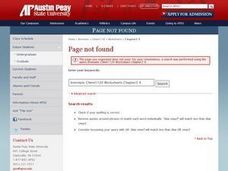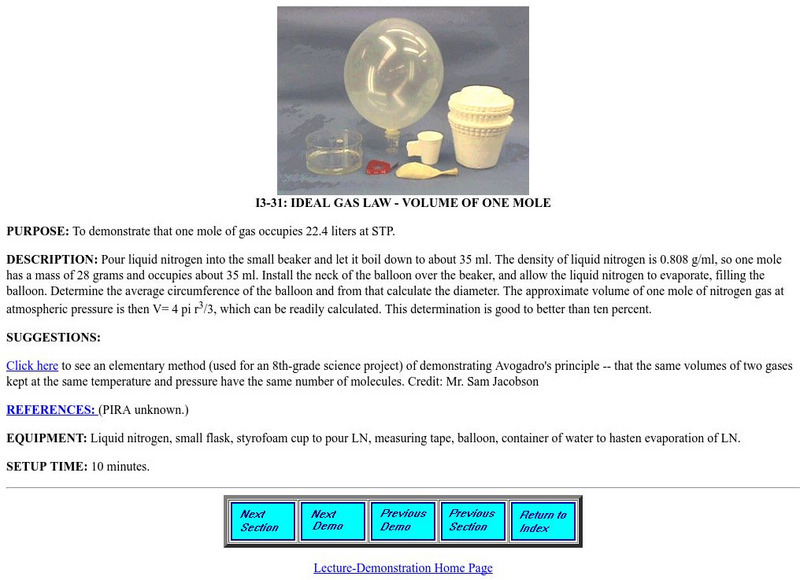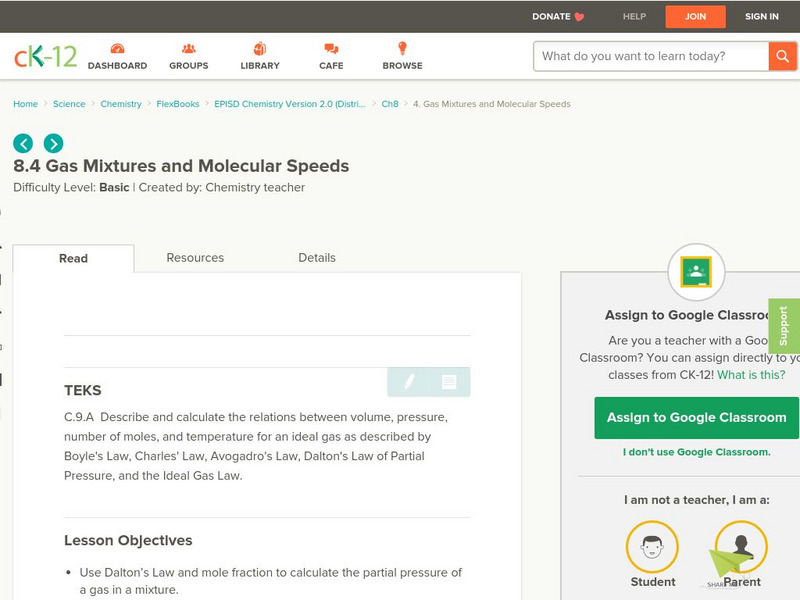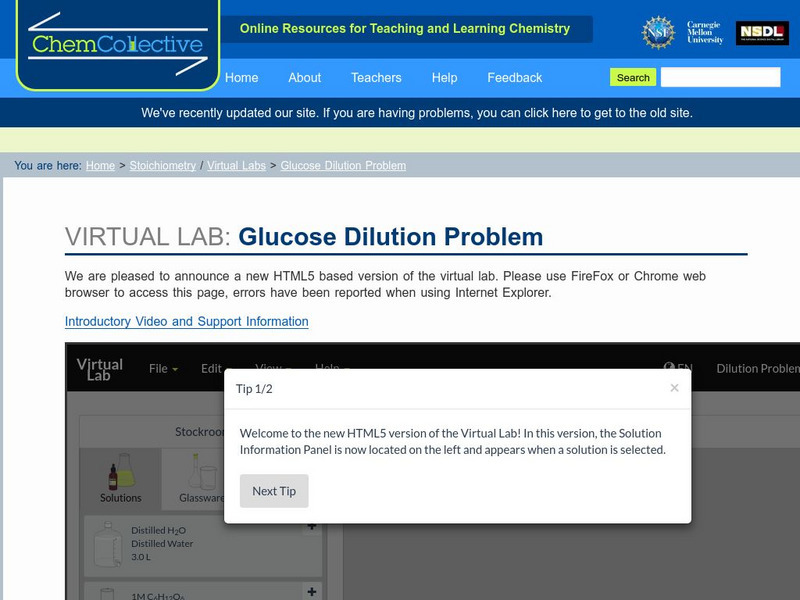Curated OER
General Chemistry I
In this chemistry worksheet, students balance each of the reactions presented using the periodic table to help. Then they predict the products of the reactions and write the net ionic equation. Students also write the empirical formulas...
Curated OER
Chemistry Lab: Solubility Product Constant of Sodium Chloride
In this solubility product constant of sodium chloride instructional activity, students gather the equipment needed and follow the procedures to determine the solubility product constant of a solute and demonstrate precipitation of a...
Curated OER
Formulas and Mole Conversions
For this formulas and mole conversion worksheet, students answer 22 graphic organizer, multiple choice, and short answer questions pertaining to formulas and mole conversion.
Curated OER
A Solution for Moles
Students calculate the concentration of different solutions. In this chemistry lesson, students explain what a solution is. They explain ways to change the concentration of a solution.
Curated OER
Ideal Gas Problems
In this ideal gas instructional activity, students review Boyle's law, Charles's law, and Avogadro's principle. Students use this information to complete 3 problems.
Curated OER
How Can We Accurately Make Different Solutions of Different Concentrations?
Young scholars work together to create different solutions made from different concentrations of liquids. They record and analyze their data. They answer discussion questions to complete the lesson.
Science Education Resource Center at Carleton College
Serc: Molar Volume of a Gas Determined via a Reaction
During this experiment, students will react magnesium with hydrochloric acid to produce hydrogen gas which is collected inside a flask that has a Vernier Gas Pressure Sensor connected to it in order to determine the molar volume of a...
Sophia Learning
Sophia: Molar Volume of a Gas: Lesson 1
This lesson will define the molar volume of a gas as the volume 1 mole of gas takes up at standard temperature and pressure. It is 1 of 2 in the series titled "Molar Volume of a Gas."
University of Colorado
University of Colorado: Ph Et Interactive Simulations: Molarity
What determines the concentration of a solution? Learn about the relationships between moles, liters, and molarity by adjusting the amount of solute and solution volume. Change solutes to compare different chemical compounds in water.
University of Colorado
University of Colorado: Ph Et Interactive Simulations: Molarity
What determines the concentration of a solution? Learn about the relationships between moles, liters, and molarity by adjusting the amount of solute and solution volume. Change solutes to compare different chemical compounds in water.
University of Maryland
University of Maryland: Ideal Gas Law Volume of One Mole
A page from the University of Maryland Physics Lecture Demonstration Facility. Provides directions for a teacher demonstration of the ideal gas law. Shows apparatus and set-up; provides suggestions. Easily adaptable as a student project...
Simon Fraser University
Chem1 Virtual Textbook: Moles and Their Uses
As part of the "Basic Atomics" section of the Virtual Textbook, this site examines moles. The information presented defines moles in relation to Avogadro's number and then goes on to describe molar mass and molar volume.
Khan Academy
Khan Academy: Molarity vs. Molality
Learn how molarity and molality differ. The molality of a solution is equal to the moles of solute divided by the mass of solvent in kilograms, while the molarity of a solution is equal to the moles of solute divided by the volume of...
CK-12 Foundation
Ck 12: Gas Mixtures and Molecular Speeds
[Free Registration/Login may be required to access all resource tools.] The following online tutorial helps students use Dalton's Law and mole fraction to calculate the partial pressure of a gas in a mixture. They will learn to calculate...
CK-12 Foundation
Ck 12: Solution Concentration
[Free Registration/Login may be required to access all resource tools.] Students will calculate the concentration of solutions in units of molarity, and use molarity to calculate the dilutions of solutions.
McGraw Hill
Mc Graw Hill Learning Center: Gas Laws and Kinetic Energy
From the companion web site for the Contemporary College Physics textbook. An ideal gas law simulation in which the motion of individual particles inside a closed container is simulated. The number of particles, external pressure, and...
CK-12 Foundation
Ck 12: Plix Series: Gas Density: Mass, Volume and the Mole
[Free Registration/Login Required] Find out what mathematical function to perform when converting between particles and moles. Then answer one challenge question about the topic.
CK-12 Foundation
Ck 12: Plix Series: Gas Density: Mass, Volume and the Mole
[Free Registration/Login Required] Find out what mathematical function should be performed in order to move from mass to moles and back again. After the activity, answer one multiple choice, challenge question about the topic.
CK-12 Foundation
Ck 12: Stoichiometric Calculations
[Free Registration/Login may be required to access all resource tools.] In the following online tutorial students will learn to calculate the amount in moles of a reactant or product from the mass of another reactant or product. They...
Michael Blaber, PhD
Florida State University: Gases: Ideal Gas Equation
The ideal gas law is derived from the empirical gas laws. The ideal gas law equation of state is listed and discussed. The universal gas constant is explained and its value is listed in five different sets of units. Standard temperature...
CK-12 Foundation
Ck 12: Ideal Gases and Gas Stoichiometry
[Free Registration/Login may be required to access all resource tools.] In the following online tutorial students will learn the Ideal Gas Law, and know which of the different values for the ideal gas constant to use in a given...
CK-12 Foundation
Ck 12: Mass and the Mole
[Free Registration/Login may be required to access all resource tools.] In the following online tutorial students will use molar mass to make conversions between mass and moles of a substance and they will also use the mole road map to...
Chemistry Collective
Chem Collective: Creating a Stock Solution
In this activity, students use the virtual lab to create dilute solutions from a concentrated stock solution of acids or bases. They must first calculate the correct volumes of concentrated acid solution and water to mix together to...
Chemistry Collective
Chem Collective: Glucose Dilution Problem
In this activity, students use the virtual lab to create a 0.025M glucose solution from a standard 1M glucose solution. First, they calculate the correct volumes of 1M glucose solution and water to mix together to create the final 0.025M...























